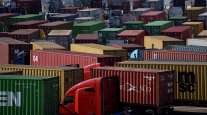Senior Reporter
Recession Began in February, Economists Say

[Ensure you have all the info you need in these unprecedented times. Subscribe now.]
The U.S. economy fell into a recession in February, a group of economists with the National Bureau of Economic Research said June 8, and some within the trucking industry are not predicting a rapid return to pre-pandemic levels.
“The unprecedented magnitude of the decline in employment and production, and its broad reach across the entire economy, warrants the designation of this episode as a recession, even if it turns out to be briefer than earlier contractions,” NBER’s Business Cycle Dating Committee said.
The committee is part of the nonprofit research group that monitors the health of the economy and determines when a recession officially begins and ends.
NBER Business Cycle Dating Committee has determined that a peak in monthly US economic activity occurred in February 2020, ending 128-month-long expansion. The committee's statement https://t.co/SWPZ4Ydw4X
FAQ at https://t.co/QPAj52A7bj
Questions to Charles Radin caradin@nber.org — NBER (@nberpubs) June 8, 2020
The economy may have hit bottom in late April and May as the recession deepened. Still, economists who spoke with Transport Topics are expressing pessimism it will quickly bounce back in what’s known as a V-shaped recovery, when the economy drops significantly, but comes roaring back.
“I think this is not a V-shaped recovery,” American Trucking Associations Chief Economist Bob Costello told TT. “I think this is more of a Nike swoosh recovery, not a V-shaped recovery. Even if you assume the 2.5 million jobs added last month, after more than 20 million lost, it’s not even close to coming back. I wasn’t doing cartwheels on Friday before they made the announcement.”
The February designation as the start of the recession is earlier than some economists had been saying; they cited mid-March as a more likely beginning point, when hundreds of thousands of businesses shut down and millions of Americans were laid off or furloughed as a result of the coronavirus.
The latest forecast from the National Retail Federation and Hackett Associates released June 8 says one indication of a slowly recovering economy is its monthly Global Port Tracker, which monitors activity at the ports.
U.S. ports followed by NRF and Hackett handled 1.61 million 20-foot-equivalent units or TEUs in April. That’s down 7.8% from a year earlier but up 17% from a four-year low seen in March and significantly better than the 1.51 million TEUs previously expected.
Hackett Associates founder Ben Hackett also is forecasting a slow recovery, especially as many businesses are just now returning, and a high percentage are operating at less than 100% capacity.
“Getting 40 million people back to work will take time, especially with many fearful of catching the virus and staying home. That makes a rapid return to an economic boom unlikely,” he said.
I think this is more of a Nike swoosh recovery, not a V-shaped recovery.
ATA Chief Economist Bob Costello
Rajeev Dhawan, director of the Economic Forecasting Center at Georgia State University, told TT the multitrillion-dollar stimulus legislation passed by Congress and signed by President Donald Trump kept the nation from sliding into a deeper recession, and possibly a depression.
“The evidence that’s coming in is that some kind of a bottom has been reached,” he said. “All the money that we have channeled into the economy both from the Federal Reserve and federal government, the Paycheck Protection Program and all the others seem to be working. They have taken out the possibility of an endless spiral downward.”
Dhawan said the recovery will be dictated by how well the medical and scientific community can combat the coronavirus, and creating a vaccine is essential. He forecasts it could take 12 to 18 months for the economy to return to pre-pandemic levels.
“I think we reached a low a few weeks ago, and it will start to recover, but it’s not going to be a rocket ship in terms of a recovery. It’s going to be a long climb. We’re doing triage.”
Despite the slumping economy, FTR Intel, a Bloomington, Ind., research organization, said an uneven recovery is taking place in the trucking industry as freight volumes are showing signs of picking up but with plateaus.
The holiday week creates noise in the data, but volumes continue to inch towards “normal”. View FTR's updated COVID-19 Freight Recovery Index by visiting our COVID-19 Intelligence page ➡ https://t.co/1gXhgLmdC5#Trucking #Rail #Freight #Transportation #Logistics #Recovery pic.twitter.com/q2kVVcJJAn — FTR (@FTRintel) June 2, 2020
FTR has created a COVID-19 Truck Freight Recovery Index, with 100 being a return to pre-pandemic levels. The week of June 1, the full index registered 66.3, placing it in the upper tier of the “restart phase.” A number above 80 is considered in the “full recovery phase.” The index reached the bottom April 17 when it hit 28.9.
FTR said the dry van sector had been the best performing of the three sectors, now reaching 82.9 after falling to 42.6 on April 24. The refrigerated sector has been in a more narrow band since early May, and it is at 67.3 after sliding to 39.9 on April 16. The flatbed sector is at 58.9 after bottoming out at 20.7. Anything in the freight recovery index below 40 is considered in the shutdown phase.
ATA’s Costello said that like the economy, trucking is slowly recovering.
“Trucking is doing OK,” he said. “I do think as we get into June and more places open up, I would fully expect freight to improve. A lot of people didn’t have the opportunity to spend during the pandemic, and everyone was in their homes. So, I do think there is some pent-up demand for spending, and that should help freight as we go forward.”
Want more news? Listen to today's daily briefing:
Subscribe: Apple Podcasts | Spotify | Amazon Alexa | Google Assistant | More





